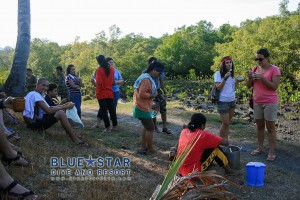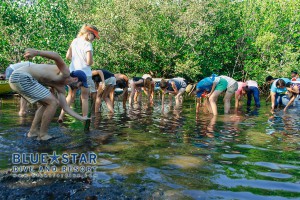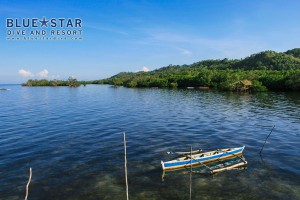Mangrove plantations in Vietnam, Thailand, the Philippines and India host several commercially important species of fishes and crustaceans. Despite restoration efforts, developers and others have removed over half of the world’s mangroves in recent times. (source: Wikipedia).
So, yesterday, we went Mangrove planting!
The local government of the Municipality of Anda Bohol ![]() is very committed to the environment and has set a goal to protect nature in the immediate vicinity of the village as well as educating the people in the entire Province about preserving the eco system. Various activities such as beach clean–ups and waste separation are very high on the agenda. For yesterday was a “Mangrove Plant Day“ organized and our guests were of course also present, along with a French group of volunteers who work on several projects in the Philippines, a lot of local people and even a few soldiers of the Philippine army who are stationed in the Marine Sanctuary gave a hand.
is very committed to the environment and has set a goal to protect nature in the immediate vicinity of the village as well as educating the people in the entire Province about preserving the eco system. Various activities such as beach clean–ups and waste separation are very high on the agenda. For yesterday was a “Mangrove Plant Day“ organized and our guests were of course also present, along with a French group of volunteers who work on several projects in the Philippines, a lot of local people and even a few soldiers of the Philippine army who are stationed in the Marine Sanctuary gave a hand.
Hundreds of seedlings were present, ready to be planted and everybody was ready to get wet, sweaty and muddy. The planting of the seedlings took around two and a half hours, until all were ready for a cooling off in the shadow and some Porridge brought by the organizers of the project.
Once established, mangrove roots provide an oyster habitat and slow water flow, thereby enhancing sediment deposition in areas where it is already occurring. The fine, anoxic sediments under mangroves act as sinks for a variety of heavy (trace) metals which colloidal particles in the sediments have scavenged from the water. Mangrove removal disturbs these underlying sediments, often creating problems of trace metal contamination of seawater.
Mangrove swamps protect coastal areas from erosion, storm surge and tsunamis. The mangroves’ massive root systems are efficient at dissipating wave energy. Likewise, they slow down tidal water enough so its sediment is deposited as the tide comes in, leaving all except fine particles when the tide ebbs. In this way, mangroves build their own environments. Because of the uniqueness of mangrove ecosystems and the protection against erosion they provide, they are often the object of conservation programs, including national biodiversity action plans.
 The unique ecosystem found in the mesh of mangrove roots offers a quiet marine region for young marine organisms and forms a pretty good nursery. In areas where roots are permanently submerged also algae, barnacles, oysters, sponges, and bryozoans, which all require a hard surface for anchoring while they filter feed, find a nice place to live. Shrimps and mud lobsters use the muddy bottoms as their home. Mangrove crabs munch on the mangrove leaves, adding nutrients to the mud for other bottom feeders.
The unique ecosystem found in the mesh of mangrove roots offers a quiet marine region for young marine organisms and forms a pretty good nursery. In areas where roots are permanently submerged also algae, barnacles, oysters, sponges, and bryozoans, which all require a hard surface for anchoring while they filter feed, find a nice place to live. Shrimps and mud lobsters use the muddy bottoms as their home. Mangrove crabs munch on the mangrove leaves, adding nutrients to the mud for other bottom feeders.
This post is also available in: German

















Recent Comments